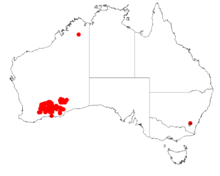Acacia camptoclada is a shrub belonging to the genus Acacia and the subgenus Phyllodineae endemic to arid parts of Western Australia.
| Acacia camptoclada | |
|---|---|
| Scientific classification | |
| Kingdom: | Plantae |
| Clade: | Tracheophytes |
| Clade: | Angiosperms |
| Clade: | Eudicots |
| Clade: | Rosids |
| Order: | Fabales |
| Family: | Fabaceae |
| Subfamily: | Caesalpinioideae |
| Clade: | Mimosoid clade |
| Genus: | Acacia |
| Species: | A. camptoclada
|
| Binomial name | |
| Acacia camptoclada | |

| |
| Occurrence data from AVH | |
The low spreading to erect shrub typically grows to a height of 0.2 to 1.0 metre (1 to 3 ft).[1] It has slightly sticky and polished branchlets with easily detached stipules. The crowded, ascending to erect glaucous green phyllodes have an asymmetrical oblanceolate to narrowly oblong shape.[2] It blooms from August to October and produces yellow flowers.[1] The inflorescences occur in groups of two to five and have showy spherical heads containing 15 to 21 golden flowers. The seed pods that form after flowering are coiled with a width of 4 to 5 mm (0.16 to 0.20 in) and contain ovate to elliptic shaped shiny black seeds with a length of around 3 mm (0.12 in).[2]
The shrub belongs to the Acacia prainii group and is closely related to Acacia dorsenna and Acacia prainii.[2]
It is native to an area in the eastern Wheatbelt and Goldfields-Esperance regions of Western Australia where it is found in low-lying areas, on sandplains and dunes growing in sandy or clay soils.[1] The range extends from Newdegate in the west to around Balladonia in the east and is often part of mallee or Eucalyptus woodland communities.[2]
See also
editReferences
edit- ^ a b c "Acacia camptoclada". FloraBase. Western Australian Government Department of Biodiversity, Conservation and Attractions.
- ^ a b c d "Acacia camptoclada". World Wide Wattle. Western Australian Herbarium. Retrieved 30 March 2019.